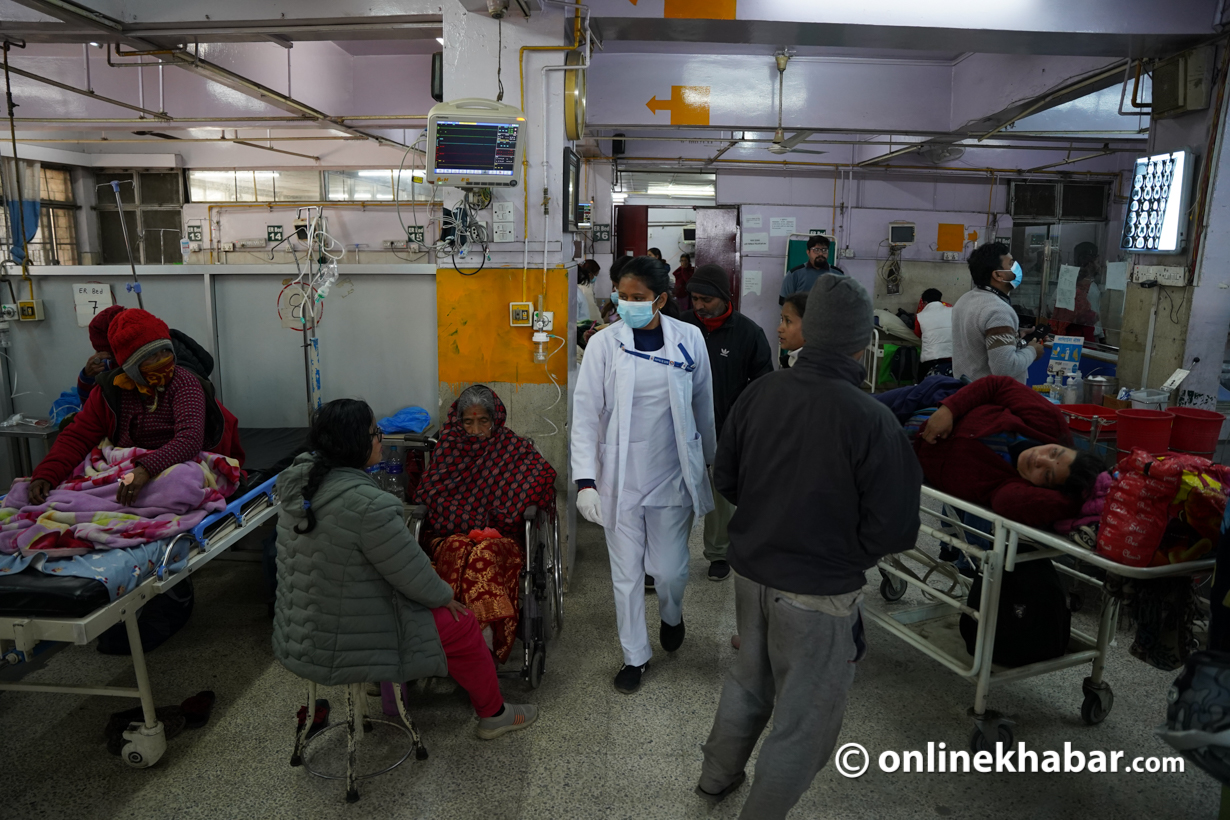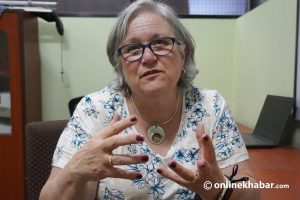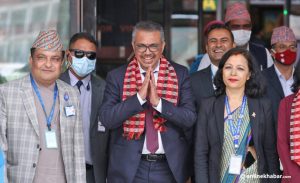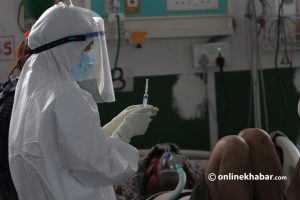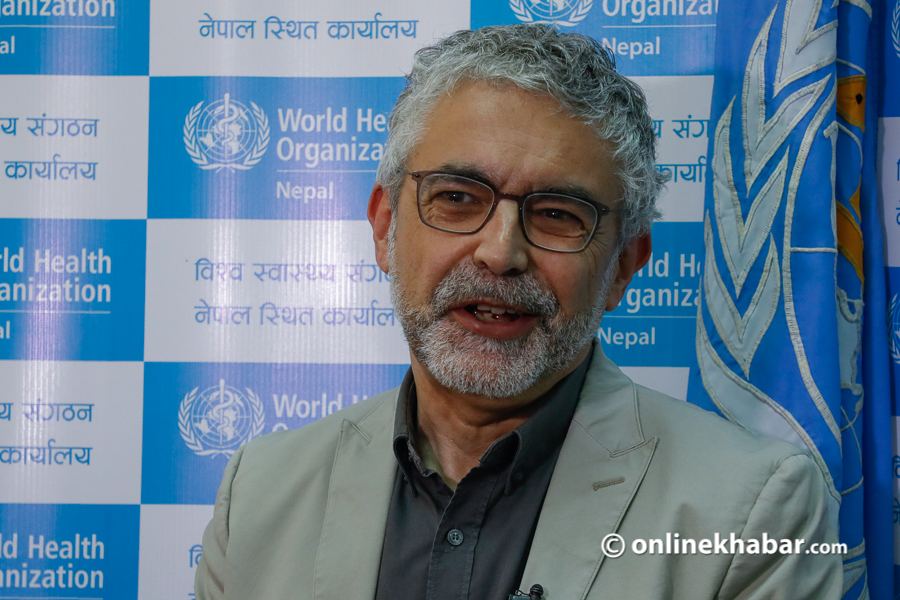
Onlinekhabar on June 13 published an interview with the World Health Organisation Representative to Nepal, Dr Jos Vandelaer, in which he supported the government policy of restricting the range of polymerase chain reaction (PCR) tests, stressing it should now focus on improving the quality of quarantine to control the coronavirus outbreak in the country. Following the interview, we received a number of queries from our readers regarding his views on rapid diagnostic tests (RDTs) that some quarantine camps in Nepal have been using to decide whether to continue quarantining people or sending them home. While everyone agreed that the quarantine camps should maintain a standard, they were worried about the status of the camps in Nepal.
Hence, immediately after the interview’s publication, Onlinekhabar approached Dr Vandelaer again for a follow-up interview. Citing a marathon of meetings, he only gave us a 10 minutes’ time on Tuesday (June 23). This time, the WHO chief in Nepal has clarified certain conditions are essential for the government policy of shrinking the range of PCR tests to work. He says if and only if required safe distancing is ensured in quarantine camps, releasing people without symptoms from quarantine after two weeks does not need any test, neither the PCR ones nor the RDTs.
Excerpts:
What is the WHO’s observation of the use of RDTs in diagnosing Covid-19 cases and deciding treatment? As far as we know, the WHO has approved such tests for research purpose only, but the government of Nepal is promoting its use to decide whether to quarantine people and how long. Do you have any comment on this practice?
Rapid diagnostic tests (RDTs) and real-time polymerase chain reaction (RT-PCR) tests are very different. The PCRs detect the virus in you. The RDTs do not detect the virus, but the antibodies produced by your body in response to an infection. It takes 10 to 14 days to produce the antibodies after the infection happens. Therefore, when you detect antibodies, very often, the worst of the infection is already passed. The RDTs, therefore, also do not tell you whether you are currently harbouring the virus; the PCR does that.
Therefore, when you use the RDTs, you are looking for antibodies; you are kind of looking backwards to know whether the person has been in touch with the virus. The PCR tests whether the person is currently harbouring the virus.
The WHO’s advice for the use of the RDTs is for surveys or surveillance. They are used for looking in large groups of people to see what proportion of that population has antibodies and that what proportion of the population in the past has been in touch with the virus. That is different from looking into whether the person is actually harbouring the virus.
In the past weeks, many people once sent home from quarantine after they tested negative in the RDTs have tested positive for coronavirus in the PCR tests. Should not have the government stopped the use of the RDTs to make such crucial decisions–apparently because those sent to the community after such tests can transmit the virus to other people?
If people are held in quarantine for 14 days and done properly, the virus is normally no longer present when the people do not show symptoms because the lifespan of the virus does not go beyond 14 days. Regardless of what you do, as long as you make sure people maintain distance in quarantine and do not infect each other etc, after 14 days, you can send people home without any test. If you want to test if somebody still harbours the virus, you will have to do the PCR.
Have any WHO staff or their representatives have visited quarantine sites in Nepal in person? Has your office shared their observation and evaluation of quarantine sites to the government officials?
The WHO personnel indeed have visited several quarantine sites and have shared their observations with the government. We also understand that as the situation progresses, there are fewer people in the quarantine sites nowadays than there were several weeks ago. And also, local authorities are taking measures to make these sites more adhering to the basic standards.

Due to Nepal’s limited lab capacities which we talked last time, many samples remain waiting to be tested for up to two weeks. Does it affect the credibility of the results?
Of course, when you take a sample to be tested, you want to know the result as soon as possible. If somebody tests positive, you want to be able to isolate that person from others, trace contacts, and isolate the contacts as quickly as possible so that they cannot infect other people.
We know there is a backlog with the testing currently in Nepal, which indeed leads to delays of several days. As long as the samples are kept in optimal conditions, the lab results will probably be what you would expect otherwise if they were done quicker. But, the issue is you want to know the results as soon as possible and not wait for two weeks.
Do you think there is some scientific reason that explains most Covid-19 cases in Nepal are asymptomatic? Does it suggest any change in the nature of the virus as it spreads in different regions?
There is currently no evidence that the virus currently circulating or found in Nepal is different, genetically, from the virus elsewhere in the world. The reason why we find so many asymptomatic patients in Nepal is the way people are being selected for testing. In Nepal, by and large, people tested and testing positive are people who have returned from India, who were mainly working as migrant labourers. Most of these people are young men. What we see with Covid-19 is that the older you get, the worse symptoms you get. Because it is mainly young people who are being tested, it is not really surprising that we do not see symptoms or only very mild symptoms—that is what you would expect in that age group. That has nothing to do with anything that the virus in Nepal is different from elsewhere.
But, interestingly, most of the Nepalis who died of Covid-19 tested positive for coronavirus after their death. Does it suggest anything significant? Or is it perfectly normal?
I do not know much details of the specific cases. But, what sometimes happens is that when a patient is sick, they go to the hospital and the sample is collected. And, unfortunately when the patient dies, sometimes the result comes out after that. That is sometimes reported as if the patient has tested positive after death. But, it actually means the sample was taken while the patient was still alive and, meanwhile, unfortunately, the patient passed away.







